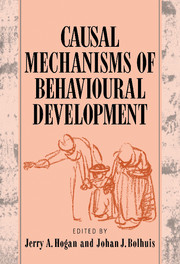Book contents
- Frontmatter
- Contents
- List of contributors
- Foreword: Introducing Jaap Kruijt
- Preface
- Part one Introduction
- Part two Development of perceptual and motor mechanisms
- 3 The neural basis for the acquisition and production of bird song
- 4 Sexual imprinting as a two-stage process
- 5 The influence of social interactions on the development of song and sexual preferences in birds
- 6 Perceptual mechanisms in imprinting and song learning
- 7 The development of action patterns
- Part three Development of behaviour systems
- Part four Development of cognition
- Part five Learning and development
- Author index
- Subject index
6 - Perceptual mechanisms in imprinting and song learning
Published online by Cambridge University Press: 19 January 2010
- Frontmatter
- Contents
- List of contributors
- Foreword: Introducing Jaap Kruijt
- Preface
- Part one Introduction
- Part two Development of perceptual and motor mechanisms
- 3 The neural basis for the acquisition and production of bird song
- 4 Sexual imprinting as a two-stage process
- 5 The influence of social interactions on the development of song and sexual preferences in birds
- 6 Perceptual mechanisms in imprinting and song learning
- 7 The development of action patterns
- Part three Development of behaviour systems
- Part four Development of cognition
- Part five Learning and development
- Author index
- Subject index
Summary
At birth, young animals are confronted with a variety of stimuli in various modalities. Individuals of precocial species, in particular, have to respond adequately within hours in order to survive. Altricial individuals may have more time available to explore the world around them, but eventually they face the same problem. Of course, the change in stimulation from before until after birth is not one from zero input to a bewildering complexity. Several senses can be stimulated before birth, and learning about features of the external world does occur before birth in both mammals and birds. Also, not all senses may be functioning at full strength at birth, making the increase in incoming stimulation less abrupt. Nevertheless, the task of making sense of the world is not an easy one. One may argue that parents may provide some guidance, but then this requires that the animal recognizes its parent, reducing, but not eliminating the problem. At the same time, ducklings, only a few hours after hatching, and fowl chicks a bit later will follow their mother as though they have known her for a long time; adult zebra finches will court conspecifics as though no other species has ever been around, and many songbirds will sing their father's song as though they had never been exposed to any other sound. However, in all these cases there is abundant evidence that interfering with normal rearing conditions of the birds may severely disrupt the natural outcome of the processes.
- Type
- Chapter
- Information
- Causal Mechanisms of Behavioural Development , pp. 116 - 146Publisher: Cambridge University PressPrint publication year: 1994
- 14
- Cited by



